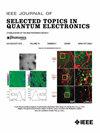高增益频域光学参数放大
IF 4.3
2区 工程技术
Q1 ENGINEERING, ELECTRICAL & ELECTRONIC
IEEE Journal of Selected Topics in Quantum Electronics
Pub Date : 2015-03-31
DOI:10.1109/JSTQE.2015.2418293
引用次数: 0
摘要
随着光学参量啁啾脉冲放大(OPCPA)和后来的非共线光学参量放大(OPA)的发明,强大的光学参量放大技术经历了巨大的进步。在本文中,我们描述了一种在频域而不是时域中进行参数交互的完全不同的方法。频域是通过光学傅立叶变换达到的,它提供了一个分离模拟。它允许将大任务分解为较小的任务,最终实现峰值功率和带宽的同时放大。第一个概念验证实验在1.8-μm波长下产生1.4mJ的两个周期脉冲,并在800nm波长下以2.5kHz的重复频率设置高增益(>2000)。在高增益条件下,已经观察到在泵浦脉冲持续时间内没有皮秒脉冲对比度退化的非常少量的寄生超荧光。本文章由计算机程序翻译,如有差异,请以英文原文为准。
High Gain Frequency Domain Optical Parametric Amplification
The powerful technique of optical parametric amplification (OPA) experienced a huge advance with the invention of optical parametric chirped pulse amplification (OPCPA) and later noncollinear OPA. In this paper, we describe a radically different approach of performing parametric interaction in the frequency domain instead of the time domain. The frequency domain is reached via optical Fourier transformation, which provides a separation ansatz. It allows breaking down a big task into smaller ones which ultimately enables simultaneous up-scaling of peak power and bandwidth. The first proof-of-concept experiment yielding 1.4 mJ, two cycle pulses at 1.8-μm wavelength is complemented by a high gain (>2000) setup at 800-nm wavelength with 2.5 kHz repetition rate. A very low amount of parasitic superfluorescence without degradation of the picosecond pulse contrast within the pump pulse duration has been observed upon high gain conditions.
求助全文
通过发布文献求助,成功后即可免费获取论文全文。
去求助
来源期刊

IEEE Journal of Selected Topics in Quantum Electronics
工程技术-工程:电子与电气
CiteScore
10.60
自引率
2.00%
发文量
212
审稿时长
3 months
期刊介绍:
Papers published in the IEEE Journal of Selected Topics in Quantum Electronics fall within the broad field of science and technology of quantum electronics of a device, subsystem, or system-oriented nature. Each issue is devoted to a specific topic within this broad spectrum. Announcements of the topical areas planned for future issues, along with deadlines for receipt of manuscripts, are published in this Journal and in the IEEE Journal of Quantum Electronics. Generally, the scope of manuscripts appropriate to this Journal is the same as that for the IEEE Journal of Quantum Electronics. Manuscripts are published that report original theoretical and/or experimental research results that advance the scientific and technological base of quantum electronics devices, systems, or applications. The Journal is dedicated toward publishing research results that advance the state of the art or add to the understanding of the generation, amplification, modulation, detection, waveguiding, or propagation characteristics of coherent electromagnetic radiation having sub-millimeter and shorter wavelengths. In order to be suitable for publication in this Journal, the content of manuscripts concerned with subject-related research must have a potential impact on advancing the technological base of quantum electronic devices, systems, and/or applications. Potential authors of subject-related research have the responsibility of pointing out this potential impact. System-oriented manuscripts must be concerned with systems that perform a function previously unavailable or that outperform previously established systems that did not use quantum electronic components or concepts. Tutorial and review papers are by invitation only.
 求助内容:
求助内容: 应助结果提醒方式:
应助结果提醒方式:


